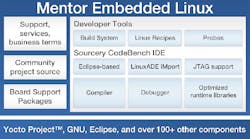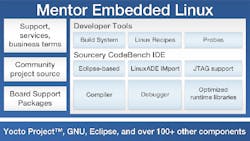AMD has signed a multi-year agreement with Mentor Graphics Corporation, to provide open-source embedded Linux development for heterogeneous and multi-core processors from AMD (Fig. 1). The agreement will provide embedded developers with more supported processor options, robust development tools and greater speed in open platform development.
I sat down with Kamal Khouri, director of embedded product management and marketing at AMD, and Kamran Shah, director of marketing for embedded software at Mentor Graphics to get the inside scoop on the partnership.
Wong: How did the partnership between AMD and Mentor Graphics come about? What capabilities does Mentor bring to AMD Embedded?
Wong: How will this partnership benefit AMD Embedded?
Khouri: Our partnership with the largest independent embedded Linux and tools vendor in the market is an exciting step for AMD as we continue to invest in the embedded market. As a Yocto Project compatible product, Mentor Embedded Linux brings standardized features and tools, and ensures quick access to the latest Board Support Packages (BSPs) for AMD 64-bit x86 architecture, beginning with the upcoming AMD Embedded G-Series system-on-a-chip (SoC) (codenamed: “Steppe Eagle”) and AMD Embedded R-Series APU/CPU (codenamed: “Bald Eagle”).
Our work with the Mentor Embedded Software Division brings a team of open source experts – including maintainers, contributors, developers and release managers – who can help AMD quickly leverage this expertise to accelerate key activities around particular market needs to help our customers deploy products quickly.
Shah: As a result of the partnership, embedded systems developers will have comprehensive access to the Mentor Embedded Linux development platform for customized embedded Linux development and commercial support, as well as a no-cost Mentor Embedded Linux Lite, a free Yocto-based Linux solution for evaluation and prototyping for the upcoming AMD “Steppe Eagle” and “Bald Eagle” products, providing all the essentials to evaluate Linux on AMD embedded processors.
To address the growing complexity of embedded systems, embedded developers will also have access to Sourcery CodeBench for greater insight into system execution, performance and debugging applications in Linux-based embedded systems.
Wong: I’m very interested to see how all of this will support AMD’s “heterogeneous” processors. Does Mentor Embedded Linux provide support for programming the GPU component of an AMD APU or otherwise support heterogeneous system architecture capabilities?
Shah: Yes, Mentor Embedded Linux will be compatible with AMD heterogeneous compute and graphics solutions. Mentor Embedded Linux commercial supports Qt and other graphics libraries and subsystems that can utilize the modern, high-performance GPU subsystems AMD has a strong reputation for.
Wong: You mention that embedded developers will be able to accelerate open source Linux development by virtue of this relationship. Can you address the development acceleration?
Related Articles
- Interview: Mentor Graphics' Chris Hallinan Discusses The Yocto Project
- Interview: Mike Woster Discusses The Yocto Project
- Industry Organizations Launch To Provide Linux Support
Khouri: Customers developing embedded products will now have access to a supported Linux distribution that is targeted to their needs and that supports AMD’s heterogeneous compute and graphics technologies. This is an exciting step because in the past, such customers would have needed to adapt some other Linux solution or roll their own, and in doing so have limited access to support.
Using a distribution based on the Yocto Project provides the first level of acceleration. Properly used, Yocto Project technology can significantly reduce the time it takes to develop, test and deploy a custom embedded Linux distribution on AMD embedded platforms. Couple that with commercial support and AMD-specific customizations available from Mentor Graphics, and customers can significantly reduce the time to market, overall development cost and program risk associated with developing a custom embedded Linux platform.
Wong: I understand that this is a multi-year agreement. How many years will this be exactly? Is Mentor Embedded Linux available on AMD platforms right now?
Shah: The initial agreement is for three years based on current roadmap projections and to reinforce to embedded developers that this is a commitment for the long-term, not a few months or even just a year. We look forward to the AMD/Mentor partnership continuing as long as there’s a need for open, Linux based development tools and support which we don’t foresee fading anytime soon. Support begins with the upcoming AMD “Steppe Eagle” and “Bald Eagle” products. Additional information about the agreement can be found on the Mentor Graphics embedded Linux solutions page for AMD.



